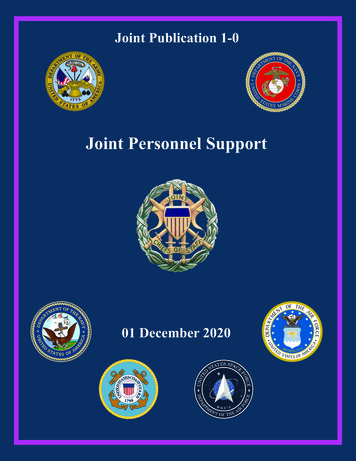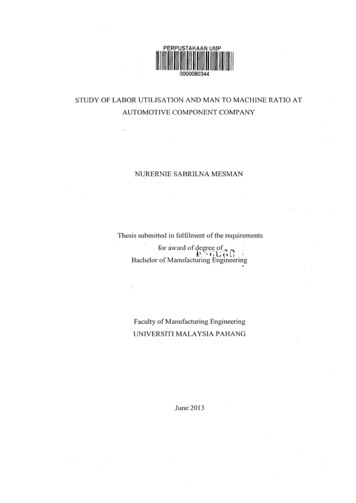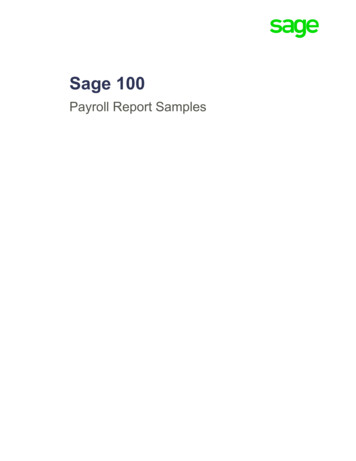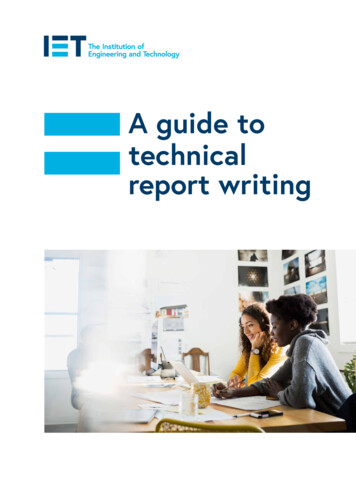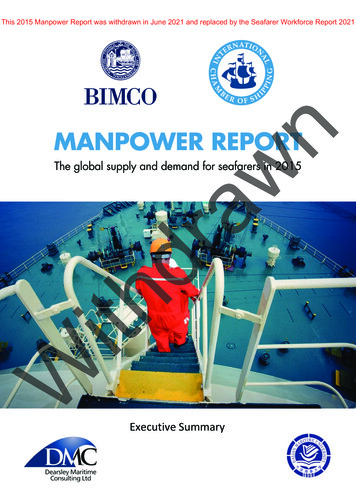
Transcription
This 2015 Manpower Report was withdrawn in June 2021 and replaced by the Seafarer Workforce Report 2021nMANPOWER REPORTWithdrawThe global supply and demand for seafarers in 2015Executive Summary
MANPOWER REPORT 2015This 2015 Manpower Report was withdrawn in June 2021 and replaced by the Seafarer Workforce Report 2021EXECUTIVE SUMMARYThe Manpower Report is a comprehensiveupdate on the global manpower situation in theshipping industry prepared by BIMCO and ICS.The report aims to provide an estimate of:n The balance between the global supply ofqualified and competent seafarers availablefor service on ships trading internationally,and the industry’s demand for seafarers tooperate the world merchant fleet;draw Details about the composition of the supplyof seafarers that operates the world merchantfleet, including their nationalities, rank/role,age profiles and gender; and The anticipated future growth of the world merchant fleet over the next ten years and its possible impacts onthe global manpower situation.MethodologyThe 2015 report follows the methodology utilised for previous BIMCO and ICS reports, however somechanges have been effected to take into account feedback from the 2010 report and to ensure that it remainsa comprehensive source of information on maritime manpower.Views and opinions from a wider range of stakeholders have been solicited and the number of ship typescovered has been expanded to offer specific information for different sectors.ithEstimated supply of seafarersThe global supply of seafarers in 2015 is estimated at 1,647,500 seafarers, of which774,000 are officers and 873,500 are ratings.WThe global supply of seafarers has increased over the past five years, with both numbers of qualified officersand ratings available to the internationally trading world merchant fleet continuing to increase. The numberof officers was reported to have increased by 34% between 2005 and 2010, and is now estimated to haveincreased by 24% in the past five years. The following figure provides a summary of how the estimated globalsupply of seafarers has increased since 2005.Summary of the estimated global supply of seafarers 1,647,500Total*Note: The estimates for 2015 are not directly comparable to previous report due to changes in approaches to data collection anddefinitions used in the scope of the report. Source: Country Questionnaire, 2015, and Manpower Reports from 2005 and 2010.10
MANPOWER REPORT 2015This 2015 Manpower Report was withdrawn in June 2021 and replaced by the Seafarer Workforce Report 2021Based on the estimates of national contributions to the current global supply of seafarers, the five countries withthe largest numbers of seafarers in 2015 are shown below.Estimated five largest seafarer supply countriesFOR OFFICERSFOR esChina3IndonesiaIndiaIndonesia4Russian FederationIndonesiaRussian Federation5UkraineRussian FederationUkraine*Source: Country Questionnaire, 2015nFOR ALL SEAFARERSdrawThe top five countries indicated by companies were China, the Philippines and the Russian Federation,followed by Ukraine and then India. This closely resembles the countries estimated to supply the largest numberof seafarers, with the exception of Indonesia.RANKTOP FIVE SEAFARER SUPPLY COUNTRIES REPORTED BY COMPANIES1China1Philippines1Russian Federation4Ukraine5India*Source: Company Questionnaire, 2015Estimated demand for seafarersithThe world merchant fleet for the purposes of the 2015 report was defined as 68,723 ships. The largestcategory was general cargo ships with 31% of the total ships by number, followed by bulk carriers with 16%and offshore supply vessels with 10%. The 2015 report has included information on the tanker industry andvarious types of offshore vessels to obtain an indication of the demand for seafarers by these sectors.The global demand for seafarers in 2015 is estimated at 1,545,000 seafarers, with theindustry requiring approximately 790,500 officers and 754,500 ratings.WThe estimated demand for officers has increased by around 24.1% since 2010, while the demand for ratingshas increased by around 1.0%. The estimated demand for officers and ratings in 2015 compared to theestimates of demand reported in previous reports is shown below.Estimated global demand for seafarers 1,545,000Total*Source: 2015 estimates and data from Manpower Reports from 2005 and 2010.11
MANPOWER REPORT 2015This 2015 Manpower Report was withdrawn in June 2021 and replaced by the Seafarer Workforce Report 2021Whereas the estimated demand for officers and ratings increased between 2005 and 2010 by 33.8% and27.5% respectively, the trend of the demand for officers has continued whilst only a small increase in demandfor ratings has appeared since 2010.Estimated supply and demand situation in 2015The estimates prepared for the 2015 report indicate that the current global supply of seafarers is around1,647,500 seafarers, of which approximately 774,000 are officers and 873,500 are ratings, and that thecurrent global demand for seafarers is around 1,545,000 seafarers, with the industry requiring approximately790,500 officers and 754,500 ratings.1,650,0001,450,000Number of 0,000drawCurrent estimated global supply and demand of seafarersnThe current supply-demand situation is a shortage of 16,500 officers and a surplus of119,000 ratings, with an overall surplus of 102,500 5002.1%15.8%6.6%WOFFICERS%*Source: 2015 estimatesRecruitment and training of seafarersRecruitment and training levels are estimated to have increased over the past five years and wastage ratesappear to have reduced below those identified in previous reports. The 2015 report provides information onturnover and wastage rates by rank and role, as well as for select seafarer supply countries.Whilst the estimated wastage and turnover rates are considered to be generally positive, the currentcontribution of recruitment and training is not sufficient to reduce the current shortage of officers or keep pacewith the forecast demand for officers in the future.12
MANPOWER REPORT 2015This 2015 Manpower Report was withdrawn in June 2021 and replaced by the Seafarer Workforce Report 2021Estimated future supply and demand for seafarersA basic forecast for the future supply-demand balance is calculated based on the information and dataobtained for the 2015 report. The report also presents nine other possible future scenarios (some demand-sideand some supply-side) that may affect the future maritime manpower situation, specifically the global supplyand demand for officers. The basic forecast is that the global supply of officers will increase steadily, but beoutpaced by increasing demand for officers.Basic forecast for the future supply-demand balance for officersn1,000,000800,000400,000200,000drawNumber of officers600,0000-16,500-9 2,000-2 mandithESTIMATED SUPPLY-DEMAND BALANCE FOR ,000-147,5002.1%11.7%18.3%%W*Source: 2015 estimatesThe 2015 report indicates that the forecast growth in the world merchant fleet over the next ten years, and itsanticipated demand for seafarers, will likely continue the trend of an overall shortage in the supply of officers.This is despite improved recruitment and training levels and reductions in officer wastage rates over the pastfive years.The current maritime manpower situation and future outlook indicate that the industry and relevant stakeholdersshould not expect there to be an abundant supply of qualified and competent seafarers in the future withoutconcerted efforts and measures to address key manpower issues. It is crucial to promote careers at sea,enhance maritime education and training worldwide, address the retention of seafarers, and to continuemonitoring the global supply and demand for seafarers on a regular basis.13
MANPOWER REPORT 2015This 2015 Manpower Report was withdrawn in June 2021 and replaced by the Seafarer Workforce Report 2021ACKNOWLEDGEMENTSThe Manpower Report was jointly sponsored by BIMCO and ICS, with the report prepared by aProject Team, guided and supported by a Steering Committee.Members of the Project ICSICSICSDavid DearsleyDM ConsultingdrawZhengjiang LiuZhiwei ZhaoJunzhong BaoZhen LiStewart InglisNatalie ShawMilly DewarnAron SørensenBIMCOPeter SandBIMCOMembers of the Steering CommitteeAnglo Eastern UK (Chairman of the Steering Committee)Ashok MahapatraDennis BarberDennis HansenGerardo BorromeoGlo RestallIan ClokePhil ParryRuna JörgensTjitso WestraTim ClarkInternational Maritime Organization (IMO)Marine ConsultantThome ShipmanagementFilipino Shipowners’ Association (FSA)Precious Alliance Ltd.UK Chamber of ShippingSpinnaker Global Ltd.German Shipowners’ Association (VDR)Royal Association of Netherlands Shipowners (KVNR)Japanese Shipowners’ Association (JSA)ithDouglas LangSpecial thanks are extended to the: Members of the Steering Committee for providing their advice and guidance during all phases of theproject. They have ensured that the report provides useful data and information for the maritime industry;W Maritime and Port Authority (MPA) of Singapore for the provision of crew data for ships visiting its port overthe period of one month. This data provided invaluable information on crewing arrangements for a varietyof ship types; and International Marine Contractors Association (IMCA) for assistance with information and advice concerningthe offshore sector.As the report has been prepared for the industry by the industry, BIMCO and ICS greatly appreciate all theassistance, time and effort of BIMCO and ICS members, and all persons, companies and organisations thatcompleted questionnaires, surveys or furnished information as part of the project.The complete Manpower Report 2015 can be purchased from Marisec PublicationsShantel.Ryan@ics-shipping.org4
of officers was reported to have increased by 34% between 2005 and 2010, and is now estimated to have increased by 24% in the past five years. The following figure provides a summary of how the estimated global supply of seafarers has increased since 2005. Summary of the estimated g
